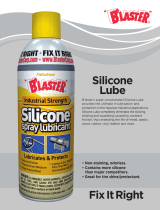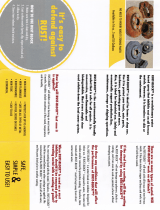Page is loading ...

RUST REMOVAL
METAL RESCUE® Rust Remover Bath is your clean, safe
and easy solution to removing rust from iron and steel.
Metal Rescue utilizes a unique and selective chelating
agent to remove rust (iron oxide) without posing any
health, safety or environmental concerns. METAL RESCUE
is safe on everything except rust! Just Soak, Check,
Rinse/Dry. It’s THAT easy!
FEATURES AND BENEFITS
CLEAN: No scrubbing, dipping, brushing, or other agitation.
SAFE: No harsh acids, no caustics, no fumes, no health
risks, non-hazardous, and safe on skin.
EASY: Soak metal pa(s) in a plastic container from
10 minutes to 24 hours depending upon the severity
of the rust, type of metal and temperature of bath.
METAL RESCUE is also available in Gel, which is great
for vertical surfaces and hard to reach areas
METAL RESCUE de-rusted pas can be used immediately
aer removal from bath.
ENVIRONMENTALLY FRIENDLY: As supplied, safe for
drain or sewer disposal--check local laws for compliance.
COST-EFFECTIVE: Saves on labor, clean up, and bath
is reusable.
METAL RESCUE will not compromise any mechanical
propeies or functionality.
Can be used in conjunction with other B’laster products.
B’LASTER METAL RESCUE PRODUCTS
WILL TAKE THE WORK OUT OF YOUR WORKDAY!
SAFE ON EVERYTHING EXCEPT RUST
WHY B’LASTER?
WE KNOW RUST. Makers of PB B’laster, the
#
1-selling penetrant since 1957 and backed
by a full line of professional-grade products,
B’laster comes from a place that demands
the toughest solutions. As Rust Belt Warriors,
B’laster products are born from professional
applications where only the strongest survive.
Our products are formulated to penetrate,
lubricate, loosen, overcome, fix & conquer
each job.
B’laster Metal Rescue
™
products are clean,
safe, easy, and protect metals while in-process,
in transpo, or in storage.
B’laster Corporation, Cleveland, OH • 1.800.858.6605 • www.metalrescue.com
Aer de-rusting, protect metal pa with Dry Coat
™
Rust Preventative spray.

B’laster Corporation, Cleveland, OH • 1.800.858.6605 • www.metalrescue.com
RUST REMOVAL
METAL RESCUE
®
RUST REMOVER BATH
EFFECTIVENESS AND COMPATIBILITY
Metal Rescue® is effective on oxides. It removes
iron oxide (rust) from ferrous based substrates.
It also removes bluing, browning, zinc phosphate,
and other oxide finishes. It effectively brightens
chrome, copper and copper alloys such as brass
and bronze.
METAL RESCUE WILL NOT DAMAGE
ANY OF THE FOLLOWING METALS:
Aluminum Gold Silver
Brass Lead Titanium
Chrome Nickel Tungsten
Nickel alloys Solder or solder points
METAL RESCUE WILL NOT REMOVE THE
FOLLOWING COATINGS:
Anodizing, Chrome, Nickel, Powder Coating and
Paint (Paint must not contain metal oxides).
METAL RESCUE IS COMPATIBLE WITH:
most materials and will not harm rubber, plastic,
clothing, glass, and other suaces unharmed by
water alone.
METAL RESCUE IS NOT
RECOMMENDED FOR USE ON
MAGNESIUM, MAGNESIUM ALLOYS,
OR GALVANIZED METAL.
CAUTION: Always wash hands thoroughly aer handling this product
and before eating. All products manufactured B’laster Corp. are
warranted to be first class products and free from defects in material
and workmanship. Liability under this warranty is limited to the net
purchase price of any of such products proven defective or at our
option to the repair or replacement of said products upon their return
to us transpoation prepaid. All claims on defective products must
be made in writing 30 days aer the receipt of such products in your
plant and prior to fuher processing or combining with other materials
and products. We make no warranty, express or implied, as to the
suitability of any of our product for any paicular use, and we shall not
be subject to liability from any damages resulting from their use in
operations not under our direct control. This warranty is exclusive of
all other warranties, express or implied, and no representative of ours
or any other person is authorized to assume for us any other liability in
connection with the sale of our products.
PROPERTIES METAL RESCUE
®
Carrier Water Based
VOC’s None
PH 6.0 - 7.0 (neutral)
Specific Gravity
as supplied
1.02
Specific Gravity of
spent solution
1.08
Optimal
Operating Temperature
68° - 150° F
(20° - 70° C)
Color Clear
Boiling Point 212° F (100° C)
Flash Point None
Shelf Life
(packaged as supplied)
Unlimited

B’laster Corporation, Cleveland, OH • 1.800.858.6605 • www.metalrescue.com
RUST REMOVAL
METAL RESCUE
®
RUST REMOVER BATH
PRODUCT OVERVIEW
Metal Rescue employs innovative new technology
that efficiently removes rust without harming
surrounding materials. It is water-based,
non-hazardous, biodegradable and environmentally
friendly to use. Metal Rescue has effectively
removed heavy rust on all types of mild steel and
iron and also removes some oxides on copper
and copper alloys such as brass and bronze.
Metal Rescue is non-flammable and contains
no petroleum solvents. It is non-hazardous,
non-corrosive, and has a neutral pH.
USE LIFE
Metal Rescue can be used again and again. One
gallon of Metal Rescue will remove 1/2 pound of
dry rust - the equivalent of removing rust from
approximately 300 pounds of moderately rusted
steel. If any Metal Rescue bath evaporates, simply
replace it with fresh tap water to its original level.
Metal Rescue’s rust removal capabilities begin to
exhaust as the bath turns black, however, it can
continue to work even when the solution is dark.
The liquid turns black because the iron oxide
paicles that are removed from the iron/steel
become absorbed into the liquid. The pH of
fully exhausted product will be approximately
7.2 and the specific gravity will change from 1.02
to 1.08. The best way to measure specific gravity
is by using a hydrometer. They are easily available
and cost between $10 and $20. It is impoant to
measure the specific gravity of Metal Rescue at
a given temperature because the temperature
of the liquid will affect the specific gravity. (For
more information on measuring specific gravity
please see the section below)
When Metal Rescue is used within a multiple
tank system, cross contamination can occur from
degreasers, coolants or other chemicals used
within the process, influencing the quantitative
measurements of pH and specific gravity.
Temperature has an effect on specific gravity
requiring that a hydrometer with temperature
capability be used. If the operation is consistent,
the temperature and any incoming contamination
fluids should be relatively consistent (except in
the case or ovelow and mechanical problems).
Record a specific gravity and pH measurement at
the beginning of the tank operation (fresh Metal
Rescue) at normal operating temperature so that
a baseline can be established. Peorm regular
recordings of specific gravity and pH 3-4 times
per shi and use these numbers to track peormance
until product fails to work as expected. The last
reading with good product results will be the
point at which the product should be titrated.
These numbers may be slightly different for all
operations due to the temperature of the fluid,
contamination type, amount of cross contamination
and mechanical issues. Consult with B’laster’s
Technical Services depament for specific
assistance with your application.
MEASURING SPECIFIC GRAVITY
A hydrometer is an instrument used to measure
the specific gravity or relative density of liquids;
that is, the ratio of the density of the liquid to the
density of water. Specific gravity measurements
are oen repoed at a given temperature because
the temperature of the liquid will affect the
specific gravity of the liquid. They are commonly
used for home brewing and wine making, and also
used by people who keep salt water aquariums.
Additionally, most manufacturing facilities with
laboratories or chemical processes have several
ways to measure the specific gravity of a liquid.
A hydrometer is usually made of glass and
consists of a cylindrical stem and a weighted bulb
at the boom to make it float upright. The liquid
to be tested is poured into a tall container, oen
a graduated cylinder, and the hydrometer is
gently lowered into the liquid until it floats freely.
The point at which the suace of the liquid touches
the stem of the hydrometer is noted. Hydrometers
usually contain a scale inside the stem, so that
the specific gravity can be read directly.
Some hydrometers also contain a thermometer
so the liquid temperature can be measured at
the same time.

B’laster Corporation, Cleveland, OH • 1.800.858.6605 • www.metalrescue.com
RUST REMOVAL
METAL RESCUE
®
RUST REMOVER BATH
TEMPERATE ALERT
Optimal operating temperatures for Metal Rescue
are 68°F (20⁰C) to 150°F (65⁰C).
DISCOLORATION
Black oxide can form on ceain steel alloys and
high carbon steel when le in Metal Rescue for
long periods of time. Black oxide is a corrosion
inhibiting film that is a more stable state of oxidized
iron. It is not detrimental to the metal suace and
is only cosmetic in nature. Reducing the time that
the pa is immersed in the liquid will minimize
the formation of black film. Much of the black
oxide film can be removed simply by rinsing with
mild detergent or wiping with a cloth. It is best to
remove black oxide immediately aer removing
pas from the Metal Rescue bath and before the
pas dry. Black oxide becomes more difficult to
remove for pas that have soaked for long peri-
ods of time. It is best to soak rusted pas only as
long as needed to remove the rust.
SHELF LIFE
An unopened bole of Metal Rescue has an
infinite shelf life. Once opened, the shelf life of
the solution will vary due to biodegradability.
Aer using Metal Rescue, it is best to cover
the bath, and allow air to flow over the suace.
Pouring used solution into a sealed container
allows anaerobic bacteria to begin the degradation
process. Open baths, covered to prevent too
much evaporation, will continue to operate
effectively for up to 12 months.
DISPOSAL
As supplied, Metal Rescue contains no VOC’s,
solvents, harsh acids, bases, or hazardous
ingredients. Metal Rescue is biodegradable aer
use and in most locations directly sewerable
unless hazardous waste or contaminants (ceain
oils, paints, heavy metals, etc.) are introduced
into the bath during use. Check local, state, and
federal disposal requirements to ensure proper
and legal disposal to the drain.
SAFETY
Metal Rescue is an extremely safe water-based
solution. It is non-corrosive, non-flammable,
non-hazardous, fume-free and does not contain
any hazardous ingredients. Fundamental safety
steps are recommended: Avoid contact with your
eyes. If eye contact occurs, flush with water. The
use of gloves is recommended, but not necessary.
PREPARATION
Pre-cleaning is not required, but excessive
suace contaminants and loose rust will slow
the rust removal process. B’laster recommends
the removal of anything that could act as a
barrier to Metal Rescue making direct contact
with the suace of the metal (di, oil, and other
contaminants). Because Metal Rescue contains
no suactants, it is highly recommended that
cosmoline, heavy greases, and similar materials
be removed prior to de-rusting.
IMMERSION
Suaces to be de-rusted must remain in constant
contact with Metal Rescue to be effective. There
are several factors that shoen or lengthen
immersion time:
• Severity of rust: Light suace rust will require
5-30 minutes, moderate rust up to 4 hours,
and heavily rusted items that have been le
unprotected for years may take up to 24 hours.
• Bath temperature: The temperature of Metal
Rescue will affect the required immersion time.
The rust removal process will proceed more
quickly at higher bath temperatures. Operating
temperatures for Metal Rescue are 68°F (20°C)
to 150°F (65°C).
RINSE
Once the rust has been removed, the entire
suace should be rinsed with water and dried
thoroughly. Items that were heavily rusted
may have loose material on the suace that
scan be removed with a brush, sponge, or high
pressure spray.
/









